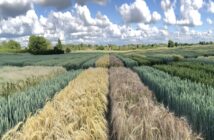The Lothians Monitor Farm is working with researchers from Scotland’s Rural College (SRUC) on a three year research project which aims to increase the number of pollinators on farm. The team believe that the changes could result in increases to crop yield.
Improving environmental sustainability is a key element of the Monitor Farm Scotland programme run jointly by Quality Meat Scotland (QMS) and AHDB Cereals & Oilseeds.
AHDB Cereals & Oilseeds Knowledge Exchange Manager Gavin Dick explains: “This project is not just about ensuring our agricultural industry becomes more productive and profitable, it also about the long-term sustainability of our land and resources. All our monitor farmers will all be making environmental improvements on farm and sharing the learning with the wider community.”
The focus of SRUC’s pollinator project will be Prestonhall Farm, part of the Lothians Monitor Farm, an arable enterprise with approximately 120 hectares for spring barley, 160 hectares winter wheat, 70 hectares winter barley, 70 hectares oilseed rape and 60 hectares oats.
SRUC agricultural ecologist Dr Lorna Cole says: “We are going to monitor how improving environmental performance of the monitor farm influences pollinators. We hope to see a greater diversity of pollinators such as bumblebees, solitary bees and hoverflies, and of course an increase in their abundance! Improving pollinator populations should improve and stabilise pollination in insect pollinated crops such as oilseed rape and field beans.
“Another benefit we hope to see is an increase in natural predators including ladybirds, spiders and parasitic wasps which should decrease the numbers of crop-damaging pests such as aphids on farm.
“We’re working on the ecological intensification theory which has shown that through increasing pollinators and natural predators crop yield is improved.”
Over the next three years the team will study the pollinator population and monitor how successful pollination has been through counting and weighing seeds. They will then relate those changes back to the arable crop yield on farm.
“Abundance and variety are the two key factors to bear in mind,” Lorna says. “If farmers can increase and diversify the population of pollinators and predators they are likely to at the very least stabilise the important ecosystem services these beneficial insects provide with positive implications to yield.
“We are seeing a lot of fluctuations in environmental conditions, extremes in weather which are likely to continue, and relying on just a few beneficial insects is risky, whereas developing these populations could offer additional protection.”
Farm Manager Bill Gray welcomes the chance to improve biodiversity on farm, but is determined that any improvement to the environmental side won’t be detrimental to the business side.
He says: “While we want to see more pollinators on farm we also want to see a corresponding increase in yield, especially if we devote more land to field margins. Being more environmentally sustainable can have a financial cost, but if that cost it recouped then it is well worth making the changes.”
The project, which is funded by the Scottish Government, will run over the next three years with results reported on a regular basis through the monitor farm network.




